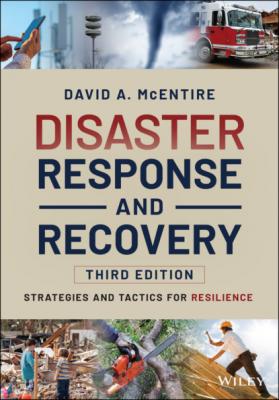Disaster Response and Recovery. David A. McEntire
Чтение книги онлайн.
Читать онлайн книгу Disaster Response and Recovery - David A. McEntire страница 20
 65–85
65–85
Important note about enhanced F‐scale winds: The enhanced F scale still is a set of wind estimates (not measurements) based on damage. It uses 3 second gusts estimated at the point of damage and wind estimates vary with height and exposure. The 3 second gust is not the same wind as in standard surface observations. Standard measurements are taken by weather stations in open exposures.
Tornadoes are very common to the Midwest portion of the United States due to the movement of the jet stream and the collision of air from Canada and the Gulf of Mexico. In fact, 90% of the world’s tornadoes take place in the United States. Although a typical year sees roughly 1,000 tornadoes, in 2011 there were 1,691 twisters, which killed 700 people and produced $25 million in damages.
Oklahoma is one of the states that is frequently impacted by tornadoes, as was the case on May 3–5, 1999. Fifty‐nine tornadoes were reported in central Oklahoma during this period, and many of them lasted several minutes and traveled great distances. At least 40 people were killed during the outbreak and 675 people were injured. Over 10,000 homes were also damaged or destroyed. Losses were estimated at $1.2 billion. Throughout history Oklahoma has experienced numerous tornadoes, including three that traveled virtually the same paths in the City of Moore. For this reason, Oklahoma and many other midwestern states are considered part of “tornado alley” ‐ the central portion of the country that is frequently prone to these types of storms. However, it should be pointed out that tornadoes have occurred in many locations around the United States including in California, Florida, Utah and many others.
Winter storms are atmospheric hazards that occur mainly in December, January and February in the United States. Such seasonal storms include snow, sleet and ice, and are associated with extremely cold temperatures (Figure 1‐3). Snowstorms include fluffy flakes of water that have frozen as they fall to the ground. While snow is often described as a “winter wonderland,” excessive snow can be a problem. On January 28, 1977, Buffalo, New York, received 93 inches of snow. This is an amount greater than the average for that area during the entire year!
When accompanied by high winds, these events can turn into blizzards. Such storms can leave several inches or feet of snow on the ground, making transportation difficult as was the case in Denver in October 1997. Up to 31 inches of snow fell in some locations and drifts were as high as 10 feet on the plains to the east of this city. Hundreds of cars had to be abandoned, and countless roads were shut down for a few days before plows could clear them.
When snow falls on steep slopes, the potential for avalanche may result. Avalanches are quick and violent movements of snow down the mountainside. They occur around the world and result in the loss of 150 lives each year. In one case, a major avalanche in Central Italy hit the 4‐story Rigopiano Hotel on the afternoon of January 18, 2017. The snow slide, which may have resulted from a series of earthquakes, moved the hotel more than 33 feet and killed 29 people. In the United States, avalanches are common in Alaska, California, Washington and states located in the Rocky Mountain region. The characteristics of snow, changing temperatures, wind, and presence of skiers and snowmobiles can trigger avalanches. In 2021, nine individuals died from avalanches while participating in winter sports in the mountains of Utah, Colorado, and New Hampshire.
Although snow and avalanches create several challenges including property destruction and fatalities, the cold temperatures associated with winter storms may also produce hypothermia in individuals who are exposed to such weather. In some cases, the heating or lighting of homes with open flames during winter storms may lead to fires that also cause death and destruction.
Figure 1‐3 The 2021 Valentine Storm resulted in snow and ice on a beach near the San Louis Hotel in Galveston, Texas (National Weather Service/Michael Garske) https://www.weather.gov/hgx/2021ValentineStorm
Sleet is another type of winter storm and it is sometimes difficult to distinguish from ice storms (even though sleet has more water in liquid state than ice storms). In any case, sleet and ice storms will cause very dangerous conditions when they accumulate on trees, power lines and the ground. Although winter storms occur most frequently in the northern, central, and western portions of the United States, it is possible for lower states to receive snow and experience ice storms periodically. For instance, Oklahoma experienced a major ice storm on October 27, 2020. This event knocked out power and destroyed countless trees/tree limbs. Making matters worse, southern states may have extra challenges dealing with ice storms since they often lack necessary snow removal/de‐icing equipment. Such storms can create major traffic problems as was the case from Amarillo to the Dallas‐Fort Worth metropolitan area in January 2007. Cars and semi‐trucks were stranded on the highway for hours and even days. Sadly, the slippery roads can prove deadly. During the early morning hours of February 11, 2021, the I‐35W freeway iced‐over just to the north of Fort Worth Texas. At least 5 people died when 133 vehicles were involved in a pile up that spanned a half a mile. The incident required that 65 people be treated at local hospitals.
For Example
Freezing Temperatures in College Station Texas
People may not give much consideration to freezing temperatures, but the consequences can be disastrous. During the historic winter outbreak in Texas in February 2021, extremely cold temperatures along with snow, sleet, and freezing rain impacted the entire state. Many records were shattered during this unprecedented “Valentines” storm system. In College Station, Texas,